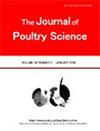肌醇-1,4,5-三磷酸受体-1和-3和赖诺定受体-3在鹌鹑卵活化过程中可能增加卵浆Ca2+
IF 1.8
4区 农林科学
Q2 AGRICULTURE, DAIRY & ANIMAL SCIENCE
引用次数: 2
摘要
我们之前报道过,日本鹌鹑的卵子激活是由两种不同类型的细胞内Ca2+([Ca2+]i)驱动的:磷脂酶Czeta 1(PLCZ1)诱导的[Ca2+]i的短暂升高和柠檬酸合成酶(CS)和乌头酸水合酶2(ACO2)诱导的长期螺旋状Ca2+振荡。尽管在微注射PLCZ1、CS和ACO2 cRNA之前阻断肌醇1,4,5-三磷酸受体(ITPR)仅阻止[Ca2+]i的短暂增加,但微注射赖氨酸受体激动剂(RYRs)诱导螺旋状Ca2+振荡,表明ITPR和RYRs都参与了这些事件。在这项研究中,我们研究了负责两种类型[Ca2+]i增加表达的ITPR和RYRs的亚型。RT-PCR和蛋白质印迹分析显示ITPR1、ITPR3和RYR3在排卵卵中表达。在显微注射PLCZ1、CS和ACO2 cRNA后3小时,即卵子激活完成的时间,这些蛋白质被降解。然而,ITPR1和ITPR3的降解,而不是RYR3的降解,在单次注射PLCZ1 cRNA后30分钟开始,对应于初始Ca2+波终止的时间。相反,在微量注射CS和ACO2 cRNA后3小时观察到RYR3降解。这些结果表明,在日本鹌鹑的卵子激活过程中,ITPRs和RYR3不同地介导[Ca2+]i的增加,并且ITPRs的下调和RYR3介导的事件分别终止了初始Ca2+波和螺旋状Ca2+振荡。本文章由计算机程序翻译,如有差异,请以英文原文为准。
Inositol-1,4,5-Trisphosphate Receptor-1 and -3 and Ryanodine Receptor-3 May Increase Ooplasmic Ca2+ During Quail Egg Activation
We previously reported that egg activation in Japanese quail is driven by two distinct types of intracellular Ca2+ ([Ca2+]i): transient elevations in [Ca2+]i induced by phospholipase Czeta 1 (PLCZ1) and long-lasting spiral-like Ca2+ oscillations by citrate synthase (CS) and aconitate hydratase 2 (ACO2). Although the blockade of inositol 1,4,5-trisphosphate receptors (ITPRs) before microinjections of PLCZ1, CS, and ACO2 cRNAs only prevented transient increases in [Ca2+]i, a microinjection of an agonist of ryanodine receptors (RYRs) induced spiral-like Ca2+ oscillations, indicating the involvement of both ITPRs and RYRs in these events. In this study, we investigated the isoforms of ITPRs and RYRs responsible for the expression of the two types of [Ca2+]i increases. RT-PCR and western blot analyses revealed that ITPR1, ITPR3, and RYR3 were expressed in ovulated eggs. These proteins were degraded 3 h after the microinjection of PLCZ1, CS, and ACO2 cRNAs, which is the time at which egg activation was complete. However, degradation of ITPR1 and ITPR3, but not RYR3, was initiated 30 min after a single injection of PLCZ1 cRNA, corresponding to the time of the initial Ca2+ wave termination. In contrast, RYR3 degradation was observed 3 h after the microinjection of CS and ACO2 cRNAs. These results indicate that ITPRs and RYR3 differentially mediate in creases in [Ca2+]i during egg activation in Japanese quail, and that downregulation of ITPRs and RYR3-mediated events terminate the initial Ca2+ wave and spiral-like Ca2+ oscillations, respectively.
求助全文
通过发布文献求助,成功后即可免费获取论文全文。
去求助
来源期刊

Journal of Poultry Science
AGRICULTURE, DAIRY & ANIMAL SCIENCE-
CiteScore
2.80
自引率
13.30%
发文量
26
审稿时长
12 months
期刊介绍:
The Journal of Poultry Science will publish original reports and reviews which either make an original contribution to fundamental science or are of obvious application to the industry. Subjects which are covered include: breeding and genetics, nutrition and feeds, physiology, reproduction, immunology, behavior, environmental science, management and housing welfare, processing and products, and health in poultry. Submission of original articles to the Journal is open to all poultry researchers. The review articles are invited papers written by international outstanding researchers. Articles will be published in English, American style.
 求助内容:
求助内容: 应助结果提醒方式:
应助结果提醒方式:


